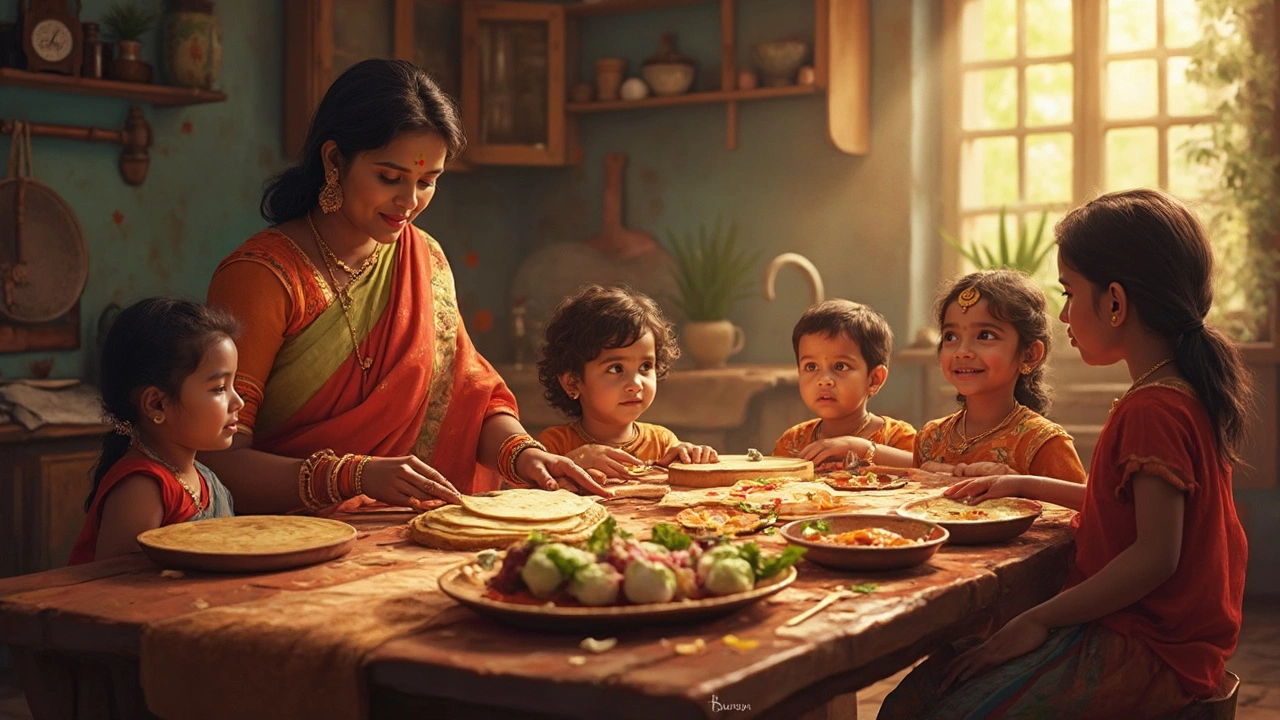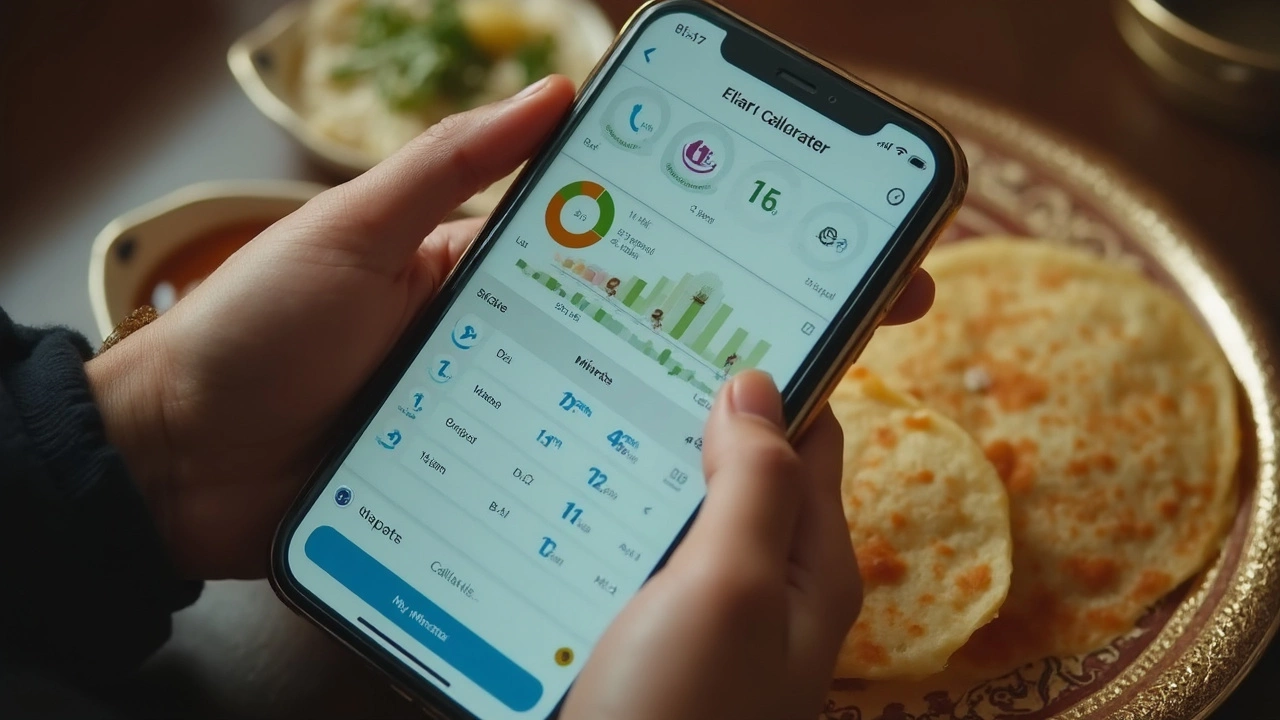Should You Eat Chapatis Daily? Here’s How Many You Need
 Feb, 28 2025
Feb, 28 2025
Chapatis, the humble flatbreads we often pair with our favorite curries, might just be a bigger part of your diet puzzle than you think. But how many should you eat daily? It all starts with understanding the basic number of calories in a single roti. Typically, a medium-sized chapati contains about 70-90 calories. This number can vary based on the size and ingredients used, but it provides a general idea for your meal planning.
Now, before you pile up your plate with chapatis, it’s crucial to figure out how they fit into your overall dietary needs. That’s where a calorie calculator comes in. This handy tool helps you track your daily calorie intake based on various factors like age, gender, activity level, and more. By knowing how much you should consume in a day, you can adjust your chapati intake accordingly.
- Understanding Calories in One Roti
- Using a Calorie Calculator
- Daily Chapati Intake by BMI
- The Local Take on Eating Chapatis
Understanding Calories in One Roti
When you're trying to figure out how many chapati to eat, it's crucial to nail down the calorie details first. A medium-sized roti, typically weighing about 30 grams, clocks in at around 70-90 calories. This includes about 2-3 grams of protein, 0.5-1 gram of fat, and roughly 15 grams of carbohydrates. These numbers can change a bit based on the flour type and any additives, like ghee or oil, used in the preparation.
Factors Impacting Calorie Count
The calorie count isn't one-size-fits-all, though. Things like the thickness of the chapati and whether you use whole wheat or refined flour can bump the count up or down. Whole wheat is often the go-to, offering a healthier balance and more fiber compared to refined flour. And, let's not forget how making them fluffy with ghee adds extra fat and calories!
Why Paying Attention to Calories Matters
If you're watching your weight or tracking your BMI, keeping tabs on calories is vital. It's like balancing a checkbook: you need to know what's coming in to manage what's going out. Using a simple calorie calculator can make it easier to match your chapati intake with your daily calorie needs.
How to Make Calorie-Savvy Choices
- Go for whole wheat chapatis over refined ones; they're more filling, helping you eat less overall.
- Avoid using oils and fats during preparation to keep the calorie count on the lower side.
- Experiment with using different types of grains like jowar or bajra, which also offer unique nutritional benefits.
Local Variations and Their Impact
In certain parts of India, like Punjab, chapatis might be made with added ghee, increasing their calorie count. Down south, people might opt for ragi flour, offering a different nutrient profile. Being mindful of these local tweaks can give you an edge in controlling your daily calorie count.
Using a Calorie Calculator
Ever wondered how to figure out the right number of chapatis for your diet? The answer often starts with a calorie calculator. It’s like having a personalized health assistant that helps you track not just calories, but also tailor your meals based on personal health data.
Let's break down how to use this tool effectively:
- Gather Your Personal Details: Age, weight, height, and activity level are the basics. Most calculators use these to estimate your daily calorie needs.
- Input Your Data: You’ll typically enter this info into the calculator. Some may even ask if your goal is to lose, maintain, or gain weight.
- Receive Your Personalized Results: The calculator spits out an estimate of how many calories you need daily. It’ll give you a good idea of how many chapatis can comfortably fit into your diet.
- Adjust Your Meals: If you know a single roti is around 70-90 calories, do a quick tally of your chapati intake along with other meals.
Now, while using a calorie calculator is pretty straightforward, there's a local twist to consider. For instance, in some parts of India, chapatis are smaller, possibly fewer in calorie content, which might affect your calculations!
Legal stuff? You bet there is. Always remember, a calorie calculator can be a guide, but it's not a replacement for professional nutritional advice. Health tools need to comply with local regulations, so seek advice from certified dietitians if in doubt.

Daily Chapati Intake by BMI
When it comes to deciding how many chapatis you should eat in a day, knowing your Body Mass Index (BMI) can be super helpful. BMI is a measurement that helps you see if you're in a healthy weight range based on your height and weight. Let's break down how you can use this to adjust your chapati consumption.
Step 1: Calculate Your BMI
First things first, you'll need to calculate your BMI. There are many online calorie calculator tools that include BMI calculations, just follow the steps, and you'll get your number. Here's the basic formula if you're curious:
BMI = Weight(kg) / (Height(m) * Height(m))
Step 2: Interpret Your BMI
Now that you have your BMI number, it's time to understand what it means:
- Underweight: BMI less than 18.5
- Normal weight: BMI 18.5 - 24.9
- Overweight: BMI 25 - 29.9
- Obese: BMI 30 or more
Knowing your category can guide your daily nutritional needs including how many chapatis you should eat in a day.
Step 3: Adjust Chapati Intake Accordingly
If you're in the normal weight range, stick to 2-3 chapatis per meal to maintain your weight. If you're underweight, feel free to add an extra chapati. Watching calories or trying to lose weight? Then 1-2 chapatis might be ideal, balanced out with lots of veggies and protein.
Local Insight: Indian Dietary Preferences
In many Indian homes, chapatis are the go-to carb choice. So, how many calories in one roti really matters! Typically, people in different states have different ways of incorporating them into meals. For instance, North Indians often have more chapatis compared to their Southern counterparts who might mix it up with rice.
Remember, maintaining a balanced diet is key. So while chapatis can definitely be part of your daily meals, they should be one part of an overall healthy lifestyle.
The Local Take on Eating Chapatis
Let’s bring it closer to home and talk about why chapatis are such a staple in Indian households. They're not just a food item; they’re a part of the culture and tradition. In many regions, meals are incomplete without a fluffy stack on the side. But how much should you fit into your daily routine?
First, remember that dietary habits are influenced by regional cooking styles. In North India, chapatis are often made with whole wheat, known for being rich in fiber and helpful in maintaining a balanced BMI. However, significant portions of South Indian cuisine might focus more on rice-based dishes instead.
When considering how many chapatis to eat per day, local dietary rules come into play. Here’s a simple way to incorporate them: if you’re following a traditional diet with three meals a day, aim to have chapatis in one or two meals instead of all three. This balance can maintain interest and variation in your diet, keeping you nourished without nutritional monotony.
Legal aspects? Not many. Unlike packaged foods, home-cooked meals, including chapatis, don’t come with strict regulations. Yet, it's wise to pay attention to public health guidelines that suggest increasing whole grain intake for better health.
| Region | Common Diet | Recommended Chapati Portion |
|---|---|---|
| North India | Wheat-based | 3-4 Medium Chapatis |
| South India | Rice-based | 1-2 Medium Chapatis |
Think of it this way: use a calorie calculator as your GPS for dietary navigation. Plug in your Body Mass Index (BMI) and daily activities for personalized guidance. Remember, local habits and personal health goals should guide your chapati intake, ensuring your diet remains delightful and beneficial.